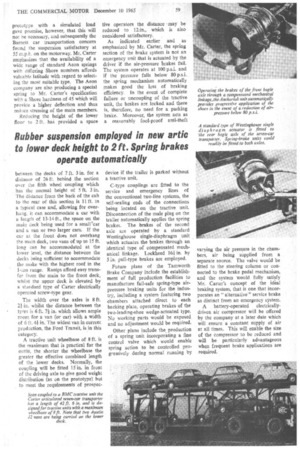Rubber suspension employed in new artic to lower deck height to 2 ft. Spring brakes operate automatically
Page 61

If you've noticed an error in this article please click here to report it so we can fix it.
between the decks of 7 ft. 3 in. for a distance of 26 ft. behind the section over the fifth wheel coupling which has the normal height of 5 ft. 3 in. The distance from the back of the cab to the rear of this section is 11 ft. in a typical case and, allowing for overhang, it can accommodate a car with a length of 13-14 ft., the space on the main deck being used for a smalrcar and a van or two larger cars. If the car at the front does not overhang the main deck, two vans of up to 15 ft. long can be accommodated at the lower level, the distance between the decks being sufficient to accommodate the make with the highest roof in the 1-ton range. Ranips afford easy transfer from the main to the front deck, whilst the upper deck is elevated by a standard type of Carter electrically operated screw-type gear.
The width over the axles is 8 ft. 2i in. whilst the distance between the tyres is 6 ft. 74in. which allows ample room for a van (or car) with a width of 6 ft. 44•• in. The widest van in current production, the Ford Transit, is in this category.
A tractive unit wheelbase of 8 ft. is the maximum that is practical for the outfit, the shorter the wheelbase the greater the effective combined length of the lower decks. Normally, the coupling will be fitted 15 in. in front of the driving axle to give good weight distribution (as on the prototype) but to meet the requirements of prospec Seen coupled to a BMC tractive unit the Carter articulated seven-car transporter has a length of 42 ft. 6 in. and is designed for tractive units with a maximum wheelbase of 8 ft. Note that two Austin J2 vans are being carried on the lower
deck.
device if the trailer is parked without a tractive unit.
C-type couplings are fitted to the service and emergency lines of the conventional two-line systems, the self-sealing ends of the connections being located on the tractive unit. Disconnection of the male plug on the trailer automatically applies the spring brakes. The brakes of the second axle are operated by a standard Westinghouse single-diaphragm unit which actuates the brakes through an identical type of compensated mechanical linkage. Lockheed 16i in. by 5 in. pull-type brakes are employed.
Future plans of the TamWorth Brake Company include the establishment of full production facilities to manufacture fail-safe spring-type airpressure braking units for the industry, including a system featuring two chambers attached direct to each backing plate, operating brakes of the two-leading-shoe wedge-actuated type. No working parts would be exposed and no adjustment would be required.
Other plans include the production of a spring unit incorporating a fine control valve which would enable spring action to be controlled progressively during normal running by varying the air pressure in the chambers, air being supplied from a separate source. The valve would be fitted to the steering column or connected to the brake pedal mechanism, and the system would fully satisfy Mr. Carter's concept of the ideal braking system, that is one that incorporates an " alternative " service brake as distinct from an emergency system.
A battery-operated electricallydriven air compressor will be offered by the company at a later date which will ensure a constant supply of air at all times. This will enable the size of the compressor to be reduced and will be particularly advantageous when frequent brake applications are required.




























































































































